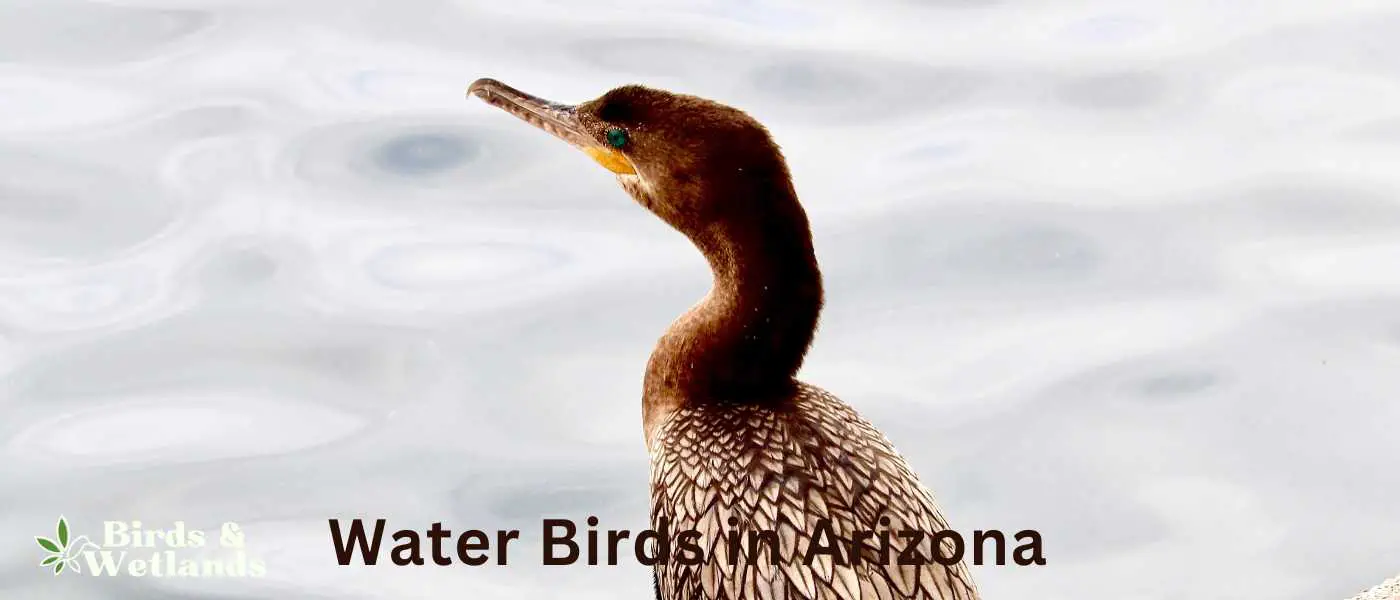Arizona, renowned for its mesmerizing landscapes, has another stunning secret – its spectacular variety of water birds. This desert paradise, surprisingly, hosts a vibrant bird-watching scene with its welcoming wetlands and rivers.
Whether you’re an avid birder or a nature enthusiast seeking a serene escape, exploring Arizona’s water birds will leave you captivated. Join us as we take a closer look at these avian wonders in the heart of the Southwest.
Arizona Water Birds
| Water Bird Species | Common Family Name | Frequency in Arizona | Specific Locations in Arizona |
|---|---|---|---|
| American Wigeon | Duck | Common | Patagonia Lake State Park |
| American Coot | Coot | Abundant | Rio Salado Habitat Restoration Area |
| Mallards | Duck | Common | Dead Horse Ranch State Park |
| Canada Goose | Goose | Common | Willcox Playa Wildlife Area |
| Northern Shoveler | Duck | Common | Kino Environmental Restoration Project |
| Ring-necked Duck | Duck | Common | Sweetwater Wetlands, Tucson |
| Ruddy Duck | Duck | Common | Gilbert Riparian Preserve |
| Neotropic Cormorant | Cormorant | Common | Papago Park, Phoenix |
| Double-crested Cormorant | Cormorant | Common | Tres Rios Wetlands, Phoenix |
| Green-winged Teal | Duck | Common | Pena Blanca Lake |
| Northern Pintail | Duck | Common | San Pedro Riparian National Conservation Area |
| Gadwall | Duck | Common | Hassayampa River Preserve |
| Lesser Scaup | Duck | Common | Lake Havasu City |
| Common Merganser | Duck | Less Common | Verde River Greenway State Natural Area |
| Great Egret | Egret | Common | Bill Williams River National Wildlife Refuge |
| White-faced Ibis | Ibis | Less Common | Cibola National Wildlife Refuge |
| Bufflehead | Duck | Less Common | Fool Hollow Lake Recreation Area |
| Snowy Egret | Egret | Common | Roper Lake State Park |
| Wood Duck | Duck | Less Common | Boyce Thompson Arboretum State Park |
| Pied-billed Grebe | Grebe | Common | Apache-Sitgreaves National Forest |
| American White Pelican | Pelican | Less Common | Lake Pleasant Regional Park |
Water Bird Species Found in Arizona
Great Blue Heron


| Feature | Measurement |
|---|---|
| Scientific Name | Ardea herodias |
| Length | 36–54 in |
| Wingspan | 66–79 in |
| Weight | 1.82–3.6 kgs |
Great Blue Herons are the largest heron species in North America, is distinguished by its tall stature and unique blue-gray plumage.
Measuring up to 4.5 feet tall with a wingspan of approximately 6.5 feet, the bird features a long, pointed bill, a white head with a black eye stripe extending to slender black plumes, and robust, elongated legs. Its distinctive flight pattern, forming a tight “S” shape with its neck, sets it apart from similar large birds, like cranes.
Inhabiting various wetland habitats, including marshes, lakes, rivers, and coastal regions throughout much of North and Central America, the Great Blue Heron is a wading bird. Often seen poised statue-like at the water’s edge, these birds are expert hunters, spearing fish and capturing small animals with their sharp bills.
American Wigeon
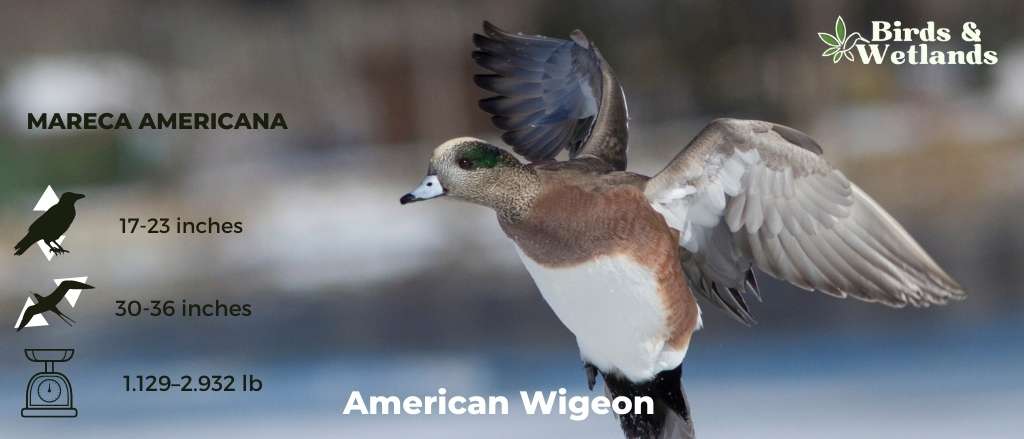
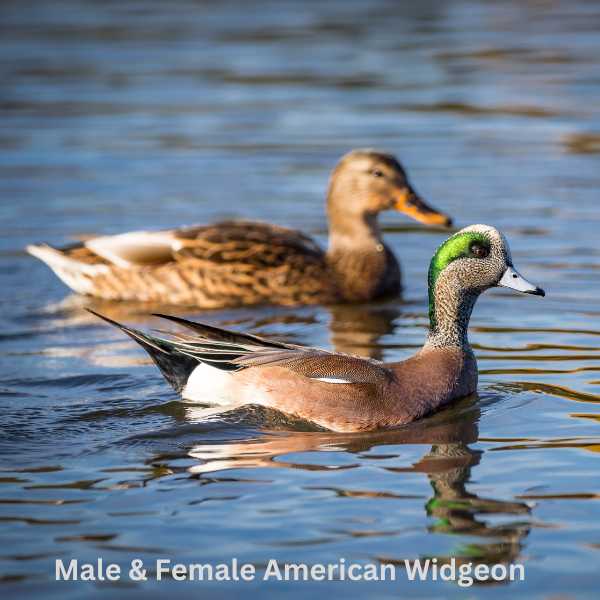
Listen to American Wigeon
Scientific Name: Mareca americana
Length: 17–23 in
Wingspan: 30–36 in
Weight: 1 –3 lb
The American Wigeon is a medium-sized duck species that is a popular sight in wetlands, ponds, and lakes and is often seen in mixed flocks with other ducks.
Males of the species are recognized by their distinctive appearance. They sport a unique white forehead and crown, coupled with a green band stretching from the eye to the back of the head. The body is mainly gray with a pinkish hue on the chest. Females are more subdued in color, with primarily gray and brown tones.
Diet: comprising mainly plant material like aquatic vegetation and grasses, but it also includes insects and other small invertebrates. They are known for a feeding behavior called “kleptoparasitism,” where they often snatch food from other ducks.
American Wigeons usually breed in the northernmost parts of North America. The females create their nests on the ground, often hidden in tall grass near water bodies. They lay a clutch of 6 to 11 eggs which they incubate for about three to four weeks and the ducklings feed on small aquatic invertebrates and aquatic insects.
American Coot

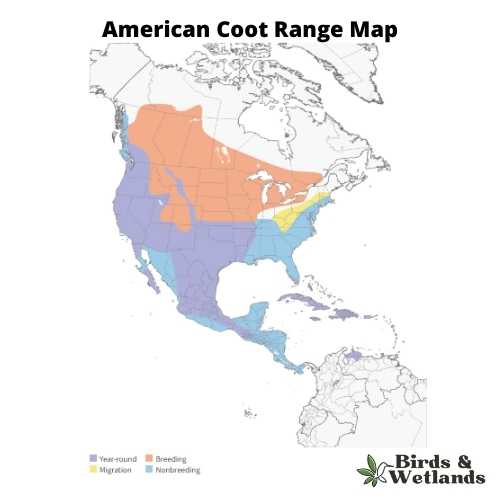
Listen:
Scientific Name: Fulica americana
Length: 13–17 in
Wingspan: 23 to 28 in
Weight: 1.270 to 1.870 lb
The American Coot is a ubiquitous water bird commonly seen in the wetlands, lakes, and ponds of North America, recognized for its adaptability and striking features.
Appearance: American Coots are easily identifiable by their slate-gray bodies, offset by a white, chicken-like bill and a red eye. Their legs are also distinctive, equipped with lobed toes, as opposed to the webbed feet seen in ducks, which assist them in navigating both land and water adeptly.
Diet: While aquatic plants form the bulk of an American Coot’s diet, they aren’t strictly herbivores. These versatile birds also consume small invertebrates and fish, demonstrating their ability to adapt and survive in a variety of habitats.
Reproduction: Nesting for the American Coot usually happens in shallow water bodies, where they construct a floating nest hidden among the vegetation. A clutch can contain between 8 to 12 eggs, all of which are incubated by both parents.
Mallard


| Feature | Measurement |
|---|---|
| Scientific Name | Anas platyrhynchos |
| Length | 20-26 inches |
| Wingspan | 32-39 inches |
| Weight | 1.6-3.5 pounds |
The Mallard, one of the most recognizable of all ducks, is distinguished by its classic “quack” and its common presence in city parks and wild wetlands.
Appearance: Mallards are large ducks with a hefty body and rounded head. The male is notable for its glossy green head, gray body, and black tail-curl, while the female is mottled brown with an orange-brown bill. Both sexes have a white-bordered, blue “speculum” patch in the wing.
Diet: Mallards are omnivorous, dabbling ducks that eat a wide variety of foods. They are known to feed on aquatic vegetation, insects, worms, and grains. In city parks, they are often seen eating bread, popcorn, and other food provided by humans, although such items are not part of their natural diet.
Reproduction: Mallards nest on the ground on dry land that is close to water, under cover of tall grass or other vegetation. The female typically lays around 8 to 13 eggs and incubates them herself.
Canada Goose


Canada Goose Sound
Scientific Name: Branta canadensis
Length: 30 to 43 in
Wingspan: 50–73 in
Weight: 5.7–14.3 lb
The Canada Goose is a large, well-known species of waterfowl noted for its distinctive appearance, familiar “honk,” and migratory behavior.
Appearance: Both male and female Canada Geese have a similar appearance, featuring a black head and neck with distinctive white patches on the cheeks and chin. The body is primarily brown with a lighter, often white, underbelly.
Diet: Canada Geese primarily feed on plant matter, including grasses, aquatic vegetation, and grains. They can often be seen grazing in parks, lawns, and fields, as well as dabbling in water bodies.
Reproduction: Canada Geese typically nest on the ground near water bodies, often on islands or other isolated areas to avoid predators. The female lays a clutch of about 4 to 6 eggs, which she incubates alone for around a month.
Northern Shoveler

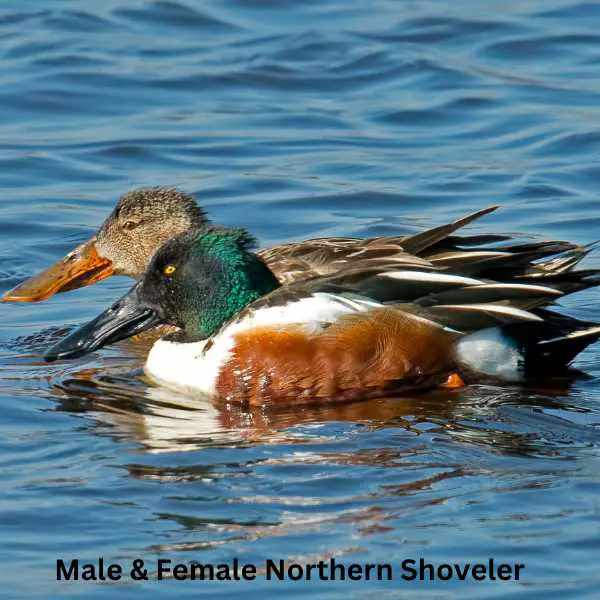
Listen to Northern Shoveler
Scientific Name: Spatula clypeata
Length: 16 in
Wingspan: 22 in
Weight: 14 oz
The Northern Shoveler is a distinct species of dabbling duck celebrated for its long, spoon-shaped bill, a feature that sets it apart from other ducks and gives the bird its name.
Appearance: Male Northern Shovelers are particularly striking, boasting a green head, yellow eyes, a large black bill, and a white chest, complemented by a chestnut-colored body. Females, on the other hand, feature a more muted color scheme, primarily displaying mottled brown feathers across their bodies and a slate-gray bill.
Diet: The Northern Shoveler’s unique bill is perfectly adapted for its feeding habits. The edges of the bill are furnished with comb-like structures that enable the bird to filter food from water. Their diet predominantly consists of aquatic invertebrates and plant matter, including seeds and algae.
Reproduction: Northern Shovelers typically nest on the ground, concealed within dense, grassy areas close to water bodies. The female lays a clutch of about 9 to 12 eggs and is solely responsible for their incubation, which lasts for about three to four weeks.
Ruddy Duck

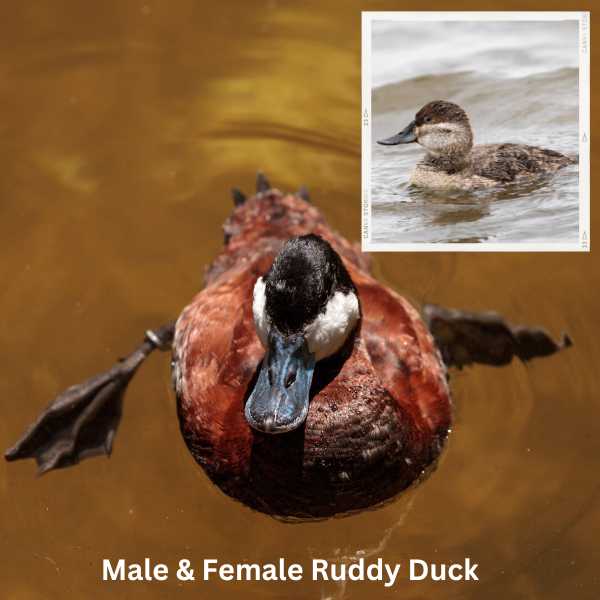
Listen
Scientific Name: Oxyura jamaicensis
Length: 13.8-16.9 in
Wingspan: 22.1-24.4 in
Weight: 10.6-30.0 o
The Ruddy Duck is a compact diving duck species recognized for its bright blue bill and stiff tail that is often held upright. These small, agile birds are found in wetlands and ponds across the United States.
Appearance: Ruddy Ducks are characterized by their distinct reddish-brown plumage, a blackish cap and nape, and a strikingly blue bill in males. The females are less vibrant, with gray-brown feathers and a dark bill. Both genders display a unique, spiky tail that often sticks upright, especially during courtship displays.
Diet: Ruddy Ducks primarily feed on a diet of aquatic invertebrates such as insects, crustaceans, and mollusks. They also consume a variety of aquatic plants and seeds. Their specialized bill allows them to sift through the water and mud to find food.
Reproduction: Ruddy Ducks nest in marshes and ponds with dense vegetation. The female typically lays a clutch of 6 to 10 eggs in a well-concealed nest built from plant material and down.
Neotropic Cormorant (Nannopterum brasilianum)

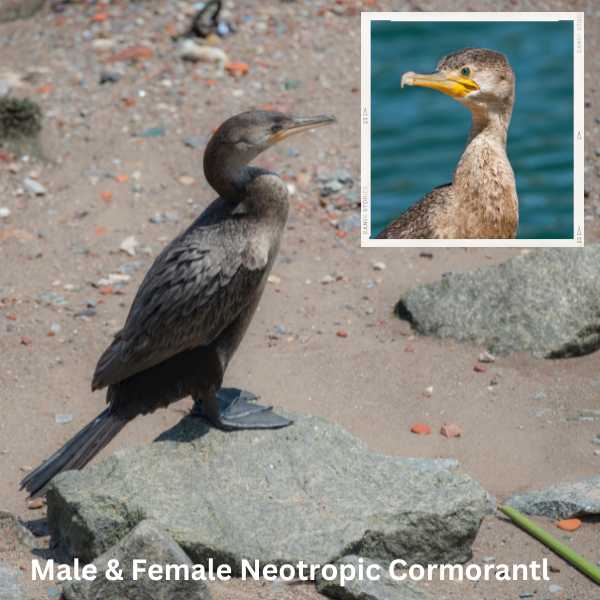
Listen
Scientific Name: Nannopterum brasilianum
Length: 28–35 in
Wingspan: 45–48 in
Weight: 2.6–5.5 lb
The Ring-Necked Duck is a small to medium-sized diving duck known for its distinctive markings and agile diving abilities.
Appearance: Male Ring-Necked Ducks are characterized by their bold black-and-white coloration, with a glossy black back, a striking white ring around the base of the bill, and two white “rings” on their flanks. Despite their name, the chestnut-colored ring around their neck is often hard to see. Females are more subtly colored with a gray-brown body and a white eye-ring.
Diet: These ducks have a varied diet that includes aquatic plants, seeds, and invertebrates, which they obtain by diving underwater in both shallow and deep water bodies.
Reproduction: The Ring-Necked Duck nests near water, often in densely vegetated areas. The female typically lays between 8 to 10 eggs, which she incubates alone, but both parents will care for the ducklings once they hatch.
Double-crested cormorant


| Feature | Measurement |
|---|---|
| Scientific Name | Nannopterum auritum |
| Length | 28–35 in |
| Wingspan | 45–48 in |
| Weight | 1.2–2.5 kg |
The Double-Crested Cormorant (Phalacrocorax auritus) is a large waterbird known for its long neck, hooked bill, and almost entirely black body. The species gets its name from the two small patches of tufted feathers or “crests” found on the heads of breeding adults, one on each side. These birds are strong swimmers that propel themselves underwater with their webbed feet, their bodies submerged and necks above the water surface, giving them a characteristic snake-like appearance when swimming.
Double-Crested Cormorants are widely distributed across North America and can be found in a variety of aquatic environments including freshwater lakes, coastal areas, and rivers. Their diet primarily consists of fish, which they catch by diving from the water’s surface. Often seen perched with wings outstretched to dry after fishing, these cormorants nest in trees, on the ground, or on cliff edges, usually in colonies. While they have rebounded from decreases in the mid-20th century due to DDT-related reproductive failures, they face ongoing threats from habitat loss, entanglement in fishing gear, and conflicts with fisheries over their consumption of fish. Protection and careful management of their habitats are key to their ongoing conservation.
Green-winged Teal
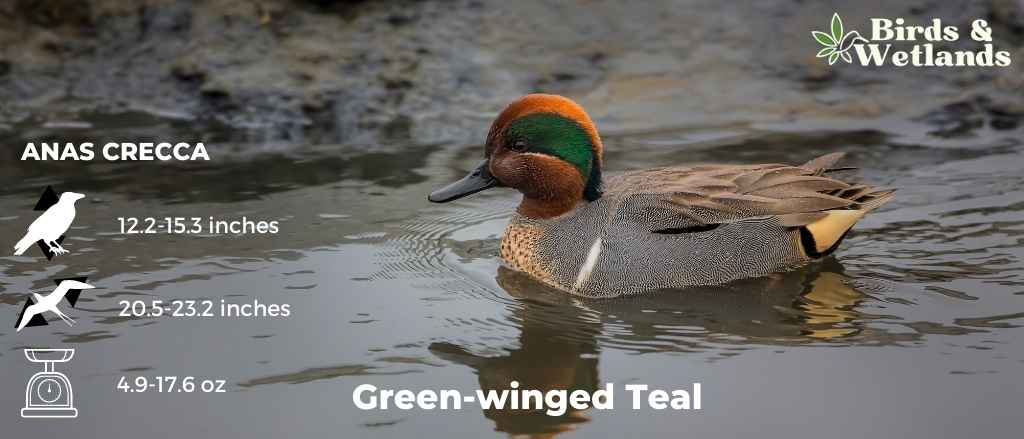
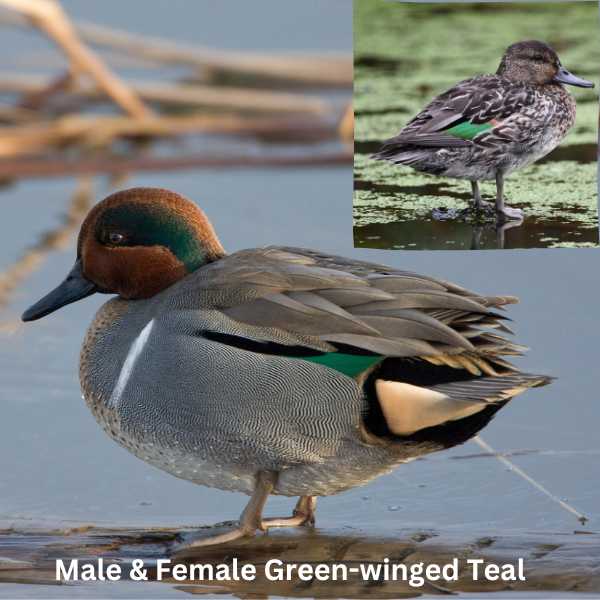
Listen to Green-winged Teal
Scientific Name: Anas crecca
Length: 12.2-15.3 in
Wingspan: 20.5-23.2 in
Weight: 14.9-17.6 oz
The Green-winged Teal is a small species of dabbling duck known for its vibrant coloration and quick, agile flight.
Appearance: Male Green-winged Teals are particularly striking with a chestnut head, a broad green streak running from the eye down the neck, and a speckled chest. The name “Green-winged” originates from the patch of iridescent green feathers visible on their wings. Females are more subtly colored, primarily in mottled brown tones that provide excellent camouflage.
Diet: The Green-winged Teal’s diet consists largely of plant matter such as seeds and aquatic vegetation. They also eat small invertebrates, particularly during the breeding season. These birds are ‘dabblers.’
Reproduction: Green-winged Teals typically nest on the ground, often concealed in dense vegetation near water bodies. The female lays a clutch of about 6 to 9 eggs, which she incubates alone for roughly three weeks.
Northern Pintail

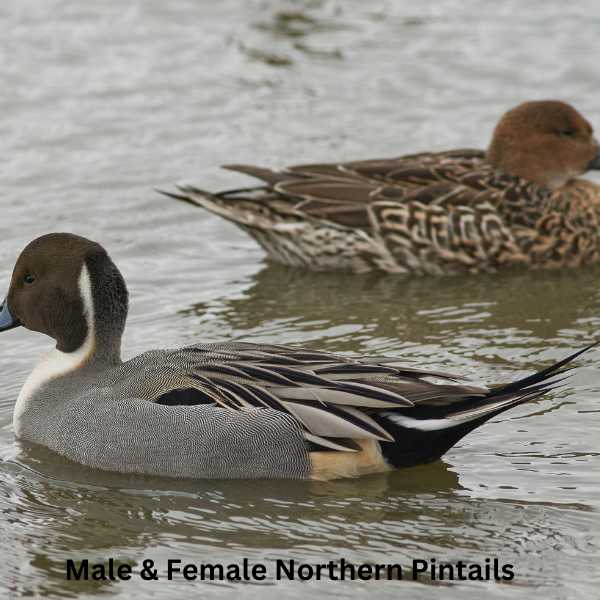
Listen to Northern Pintail
Scientific Name: Anas acuta
Length: 23–30 in
Wingspan: 31–37 in
Weight: 1 –3 lb
The Northern Pintail is a graceful species of duck recognized for their elegance in flight and their sleek bodies and long tails which is pin-shaped.
Male Northern Pintails are celebrated for their distinctive appearance, featuring a chocolate brown head, a white neck, and a grayish body. The most notable characteristic is the long, pointed tail feathers, which give this species its name. Females are more understated in color, sporting a mottled brown plumage.
Diet: Consists primarily of plant matter, including seeds and aquatic vegetation. They are also known to eat insects, especially during the breeding season. The Northern Pintail is often seen dabbling and upending in water bodies to forage for food.
Reproduction: Northern Pintails usually nest on the ground, near water bodies. The female lays a clutch of 7 to 9 eggs and is solely responsible for their incubation, which lasts for about three weeks.
Common Merganser

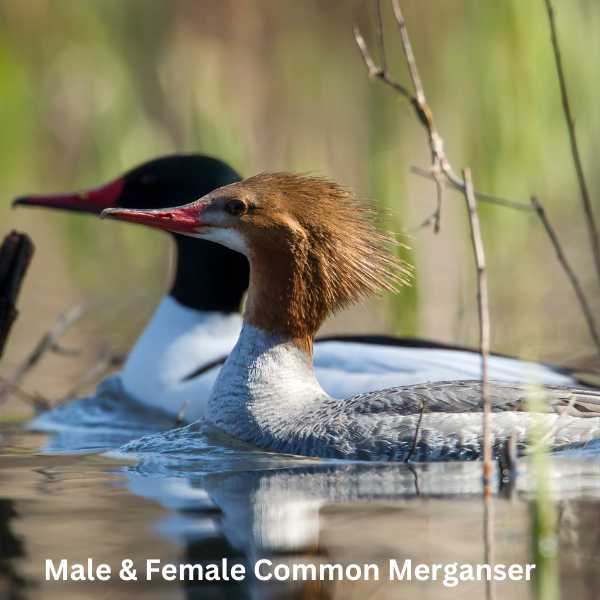
Listen:
Scientific Name: Mergus merganser
Length: 23–28 in
Wingspan: 30 – 38 in
Weight: 2 lb 0 oz – 4 lb 10 oz
The Common Merganser is a large and elegant diving duck, famous for its unique fishing abilities and seen often in the lakes, rivers, and coastal areas across North America.
Appearance: The male Common Merganser is quite striking with its dark green, almost black, crested head, bright red bill, and white body tinged with salmon-pink. The females have a reddish-brown crested head, a white neck, and a grayish body, but share the same red bill as the males.
Diet: True to their diving duck status, Common Mergansers are exceptional hunters, primarily feeding on fish. They’re also known to consume aquatic invertebrates and, on occasion, small mammals and birds. Their serrated bills are specialized to hold slippery fish tightly.
Reproduction: Like the Wood Duck, Common Mergansers also nest in tree cavities or nest boxes close to water bodies, but can also use rock crevices or holes in the ground. A clutch usually contains 9 to 12 eggs, incubated solely by the female.
Great Egret


| Feature | Measurement |
|---|---|
| Scientific Name | Ardea alba |
| Length | 31 to 41 in |
| Wingspan | 52 to 67 in |
| Weight | 1.5 to 3.3 lbs |
The Great Egret (Ardea alba), also known as the Common Egret, is a large, elegant wading bird recognized for its brilliant white plumage, slender black legs, and long, dagger-like yellow bill.
With a height of up to 3.3 feet and a wingspan of 52 to 67 inches, this bird is amongst the largest of the heron species. Its stately appearance and serene comportment have made it a popular symbol in many cultures and an eye-catching sight in its habitats.
Found across all continents except Antarctica, the Great Egret resides in both fresh and saltwater wetlands, including marshes, ponds, and coastal areas. It feeds mainly on fish, but it also hunts amphibians, small mammals, and invertebrates.
White-faced Ibis
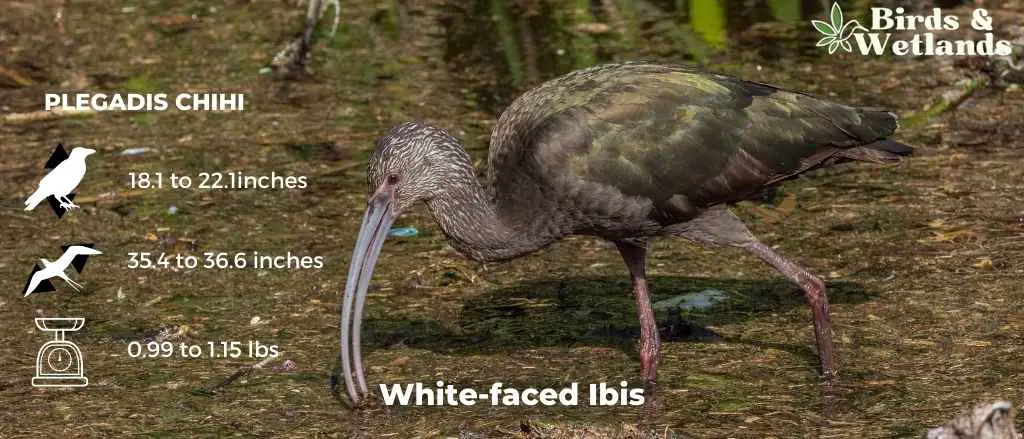
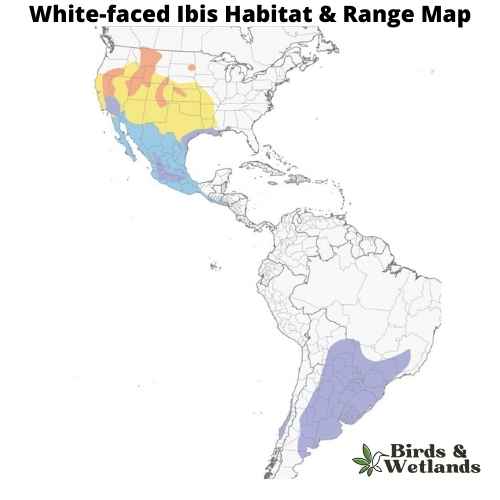
Listen
Scientific Name: Plegadis chihi
Length: 18.1-22.1 in
Wingspan: 35.4-36.6 in
Weight: 15.9-18.5 oz
The White-faced Ibis is a wading bird that is most commonly found in the marshes, swamps, and wetlands of the Western United States.
Appearance: The White-faced Ibis stands out for its iridescent dark red-brown body, a slim and curved bill, and long grayish legs. Its name comes from a distinguishing feature seen in adults – a thin band of white feathers around the base of the bill and eye during the breeding season. Its eyes are reddish, which further adds to its distinctive appearance.
Diet: The diet of the White-faced Ibis primarily consists of insects, crustaceans, snails, and small fish. With their long, curved bills, they probe into the soft mud in search of these food items.
Reproduction: The White-faced Ibis typically builds its nest in low shrubs or trees near water bodies, using sticks and other vegetation. It lays a clutch of 3 to 5 eggs that are light blue in color. Both parents share the responsibility of incubating the eggs for about three weeks.
Bufflehead


Listen to Bufflehead
Scientific Name: Bucephala albeola
Length: 13–16 in
Wingspan: 21.6 in -23.2 in
Weight: 9.5–19.4 oz
The Bufflehead is a small, compact species of diving duck known for its striking appearance and large heads and unique nesting habits.
Appearance: Male Buffleheads are easily recognized by their large, bulbous head with a green-purple iridescent sheen, a large white patch across the back of the head, and a predominantly black and white body. Females are more subtly colored, primarily in gray-brown tones with a smaller white cheek patch.
Diet: As diving ducks, Buffleheads feed by diving beneath the water’s surface. Their diet consists largely of aquatic invertebrates, such as insects, crustaceans, and mollusks, as well as some plant matter.
Reproduction: Uniquely among ducks, Buffleheads often nest in tree cavities, especially those made by Northern Flickers, a type of woodpecker. The female lays a clutch of about 6 to 11 eggs, which she incubates alone for roughly a month.
Snowy Egret

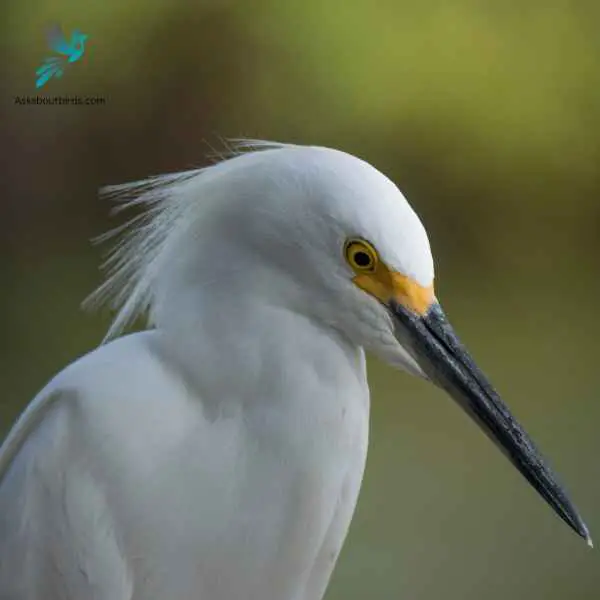
| Feature | Measurement |
|---|---|
| Scientific Name | Egretta thula |
| Length | 22.1–26.0 in |
| Wingspan | 39.4 in |
| Weight | 370 g |
The Snowy Egret (Egretta thula) is a small and active wading bird, celebrated for its delicate beauty. It sports an entirely white plumage that appears to glow against its black bill and legs, and striking yellow feet, which often play a crucial role in luring prey during feeding.
The Snowy Egret is further adorned with fine, plume-like feathers on its head, neck, and back during the breeding season, making it one of the more distinctive heron species.
Inhabiting wetland areas across the Americas, the Snowy Egret can be found in marshes, swamps, shorelines, and tidal flats where it feeds primarily on fish, but also consumes insects, crustaceans, and small reptiles.
Ring-necked Duck (Aythya collaris)


Listen
Scientific Name: Aythya collaris
Length: 15.3-18.1 in
Wingspan: 24.4-24.8 in
Weight: 17.3-32.1 oz
The Ring-Necked Duck is a small to medium-sized diving duck known for its distinctive markings and agile diving abilities.
Appearance: Male Ring-Necked Ducks are characterized by their bold black-and-white coloration, with a glossy black back, a striking white ring around the base of the bill, and two white “rings” on their flanks. Despite their name, the chestnut-colored ring around their neck is often hard to see. Females are more subtly colored with a gray-brown body and a white eye-ring.
Diet: These ducks have a varied diet that includes aquatic plants, seeds, and invertebrates, which they obtain by diving underwater in both shallow and deep water bodies.
Reproduction: The Ring-Necked Duck nests near water, often in densely vegetated areas. The female typically lays between 8 to 10 eggs, which she incubates alone, but both parents will care for the ducklings once they hatch.
Wood Duck

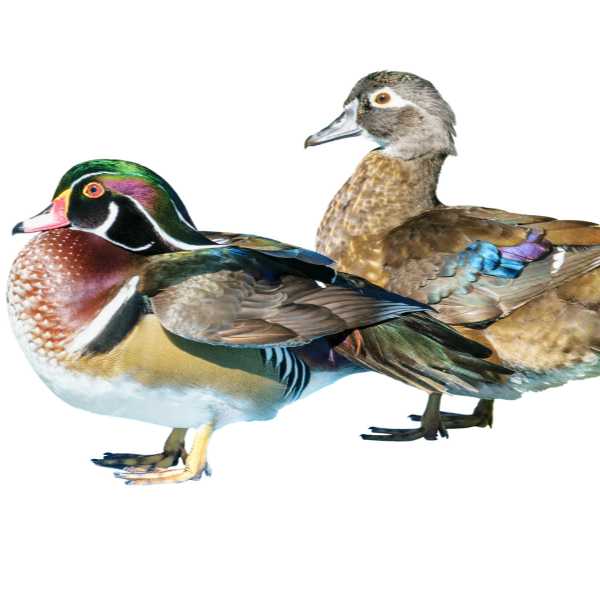
Listen:
Scientific Name: Aix sponsa
Length: 19 to 21 in
Wingspan: 26 to 29 in
Weight: 16.0-30.4 oz
The Wood Duck is an exquisitely colorful waterfowl known for its unique nesting habits and is commonly seen in wooded swamps, marshes, and streams across North America.
Appearance: With their dazzling plumage, Wood Ducks are among the most stunning birds. Males display a multitude of colors, including a green and purple crested head, red eyes, and a white-striped chest, all contrasted with a bronze-colored body. Females, though more subdued with a gray-brown body and white eye-ring, also possess their own charm.
Diet: Wood Ducks have a diverse diet that includes seeds, fruits, and insects, as well as other invertebrates. Their broad diet helps them to adapt to a variety of habitats, whether in the wild or in urban areas with suitable nesting sites.
Reproduction: Unlike most other ducks, Wood Ducks prefer to nest in tree cavities near water, leading to their common name. They will also readily use nest boxes if they’re available. A typical clutch consists of 9 to 14 eggs, which the female incubates alone.
Pied-billed Grebe
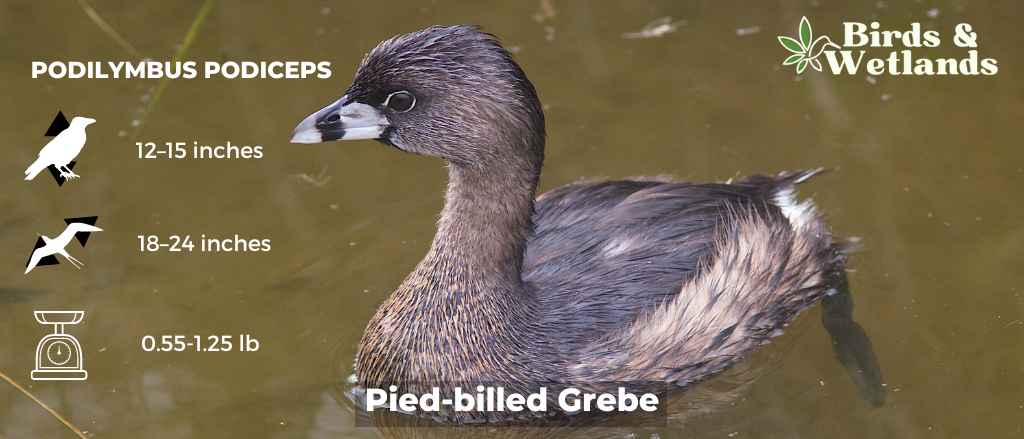
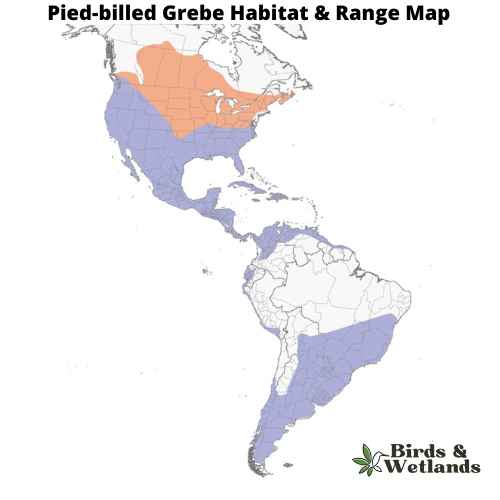
Listen:
Scientific Name: Podilymbus podiceps
Length: 12–15 in
Wingspan: 18–24 in
Weight: 8.9–20.0 oz
The Pied-billed Grebe is a small, elusive water bird well-known for its unique ability to adjust its buoyancy and often “sink” out of sight. It can be found in a wide variety of wetland habitats across the United States.
Appearance: Pied-billed Grebes have a stocky build with a short neck and a chicken-like bill that is conspicuously ringed in black during the breeding season – hence the name “pied-billed”. Their plumage is primarily a muted brown, which can vary in tone depending on the season.
Diet: Their diet consists predominantly of aquatic invertebrates, small fish, and amphibians. Pied-billed Grebes are adept divers and can stay underwater for impressive lengths of time to catch their prey.
Reproduction: Pied-billed Grebes usually nest in dense marsh vegetation, where the female lays 5 to 7 eggs. Both parents share responsibilities for incubation. After hatching, the chicks are often seen riding on their parents’ backs while they learn to navigate their aquatic world.
American White Pelican


| Feature | Measurement |
|---|---|
| Scientific Name | Pelecanus erythrorhynchos |
| Length | 50–70 in |
| Wingspan | 95–120 in |
| Weight | 3.5 and 13.6 kg |
The American White Pelican (Pelecanus erythrorhynchos) is one of North America’s largest birds, distinguished by its brilliant white plumage, elongated orange bill, and massive wingspan, which can extend up to 3 meters. This bird has a unique appearance with its distinctive pouch used for feeding and a “horn” on the upper part of the bill during the breeding season. Though a large bird, it is very graceful in flight, often seen soaring in flocks in a V formation.
American White Pelicans inhabit lakes, marshes, and salt bays, and despite their size, they are excellent swimmers. They feed primarily on fish, using a cooperative hunting strategy where they encircle schools of fish in shallow water and then scoop them up in their bill pouches. Unlike their brown pelican relatives, they do not dive for their food. During the breeding season, these pelicans will nest in colonies on islands in freshwater lakes.
Black-bellied whistling duck
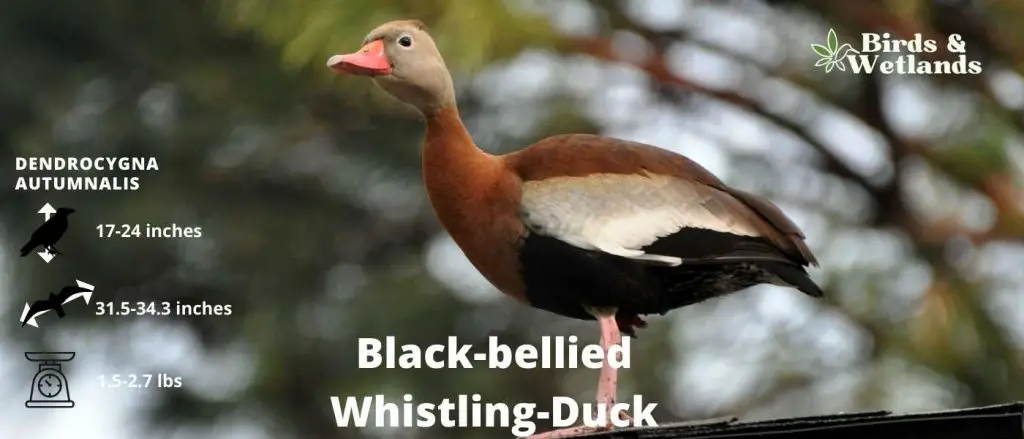

Listen
Scientific Name: Dendrocygna autumnalis
Length: 17-24 inches
Wingspan: 31.5-34.3 in
Weight: 1.5-2.7 lbs
The Black-bellied Whistling Duck is a unique species known for its high-pitched whistling call, and it is one of the few duck species that have strong monogamous relationships.
Appearance: The Black-bellied Whistling Duck is notable for its bright coral-red bill, long pink legs, and its namesake black belly. It has a grey face and chest, and its back is covered with brown feathers that give a scaled appearance. Both males and females share a similar color pattern, making it difficult to distinguish between the two.
Diet: This duck’s diet is mainly vegetarian, consisting predominantly of seeds and grains. They also consume insects, snails, and other small invertebrates. Unlike many other ducks, Black-bellied Whistling Ducks often forage on land, especially at night.
Reproduction: Black-bellied Whistling Ducks usually nest in tree cavities near water, but they will also use nest boxes. The female typically lays between 9 to 16 eggs.
Where to Spot Arizona’s Water Birds
San Pedro Riparian National Conservation Area: Located in southeastern Arizona, the San Pedro Riparian National Conservation Area is a haven for water birds. Its lush riparian habitat along the San Pedro River attracts a wide range of species, including herons, egrets, ducks, and shorebirds.
Gilbert Water Ranch: Situated in Gilbert, Arizona, the Gilbert Water Ranch is a popular spot for birdwatching, particularly for water birds. With its numerous ponds and wetlands, it attracts a diverse array of species such as coots, grebes, ducks, and occasionally even rarities like the Black-crowned Night-Heron.
Lake Havasu: As one of Arizona’s largest reservoirs, Lake Havasu offers ample opportunities to observe water birds. This scenic lake is home to a variety of species, including pelicans, cormorants, ducks, and gulls.
Sweetwater Wetlands Park: Located in Tucson, Sweetwater Wetlands Park is a man-made wetland designed to treat reclaimed water. It has become a thriving habitat for water birds, attracting species like herons, egrets, coots, and various duck species.
Buenos Aires National Wildlife Refuge: Situated near Sasabe, Arizona, the Buenos Aires National Wildlife Refuge encompasses a diverse range of habitats, including wetlands, ponds, and riparian areas. It serves as an important stopover for migratory water birds, offering sightings of herons, egrets, ducks, and shorebirds.
| Neighboring States to Arizona | Best Spots to See Water Birds |
|---|---|
| California Water Birds | 1. Salton Sea National Wildlife Refuge 2. Point Reyes National Seashore 3. Bolsa Chica Ecological Reserve |
| Nevada Water Birds | 1. Stillwater National Wildlife Refuge 2. Pahranagat National Wildlife Refuge |
| Utah Water Birds | 1. Bear River Migratory Bird Refuge 2. Great Salt Lake Shorelands Preserve |
| Colorado Water Birds | 1. Barr Lake State Park 2. Rocky Mountain National Park 3. John Martin Reservoir State Park |
| New Mexico Water Birds | 1. Bosque del Apache National Wildlife Refuge 2. Bitter Lake National Wildlife Refuge 3. Caballo Lake State Park |
Whether you’re an avid birder or a nature enthusiast seeking a serene escape, exploring Arizona birds will leave you captivated. Whether large birds, wading birds or fish eating birds that dive for their prey, these aquatic birds will leave you in awe.
Many other birds in arizona, are making their way to South America are also aquatic birs, in fact there are hundreds of species. What’s interesing to note is that breeding males (and even non breeding males) in ducks appear very different to the female ducks – strikingly so.

